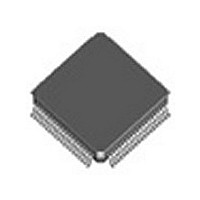82V2082PF IDT, Integrated Device Technology Inc, 82V2082PF Datasheet - Page 17

82V2082PF
Manufacturer Part Number
82V2082PF
Description
Manufacturer
IDT, Integrated Device Technology Inc
Datasheet
1.82V2082PF.pdf
(88 pages)
Specifications of 82V2082PF
Number Of Transceivers
1
Screening Level
Industrial
Mounting
Surface Mount
Package Type
TQFP
Operating Temperature (min)
-40C
Operating Temperature (max)
85C
Lead Free Status / RoHS Status
Not Compliant
Table-1 Pin Description (Continued)
PIN DESCRIPTION
IDT82V2082
MONT2
MONT1
TERM1
TERM2
Name
TRST
TMS
TCK
TDO
RST
THZ
JA1
JA0
Pullup
Pullup
Type
O
I
I
I
I
I
I
I
I
I
I
TQFP80
Pin No.
13
12
16
17
18
19
21
20
1
2
3
4
FPBGA81
Pin No.
E3
E1
G2
G1
H1
A1
B1
B2
C2
F2
F3
J2
TERMn: Selects internal or external impedance matching for channel 1 and channel 2 in hardware control mode
0 = ternary interface with internal impedance matching network
1 = ternary interface with external impedance matching network in E1 mode; ternary interface with external impedance
matching network for receiver and ternary interface with internal impedance matching network for transmitter in T1/J1
mode.
(This applies to ZB die revision only.)
In software control mode, this pin should be connected to ground.
JA[1:0]: Jitter attenuation position, bandwidth and the depth of FIFO select for channel 1 and channel 2 (only
used in hardware control mode)
•
•
•
•
In software control mode, this pin should be connected to ground.
See above.
MONT2: Receive Monitor gain select for channel 2
In hardware control mode with ternary interface, this pin selects the receive monitor gain of receiver:
0= 0dB
1= 26dB
In software control mode, this pin should be connected to ground.
MONT1: Receive Monitor gain select for channel 1
In hardware control mode with ternary interface, this pin selects the receive monitor gain of receiver:
0= 0dB
1= 26dB
In software control mode, this pin should be connected to ground.
RST: Hardware Reset
The chip is forced to reset state if a low signal is input on this pin for more than 100ns. MCLK must be active during reset.
THZ: Transmitter Driver High Impedance Enable
This signal enables or disables all transmitter drivers on a global basis. A low level on this pin enables the driver while
a high level on this pin places all drivers in high impedance state. Note that the functionality of the internal circuits is not
affected by this signal.
TRST: JTAG Test Port Reset
This is the active low asynchronous reset to the JTAG Test Port. This pin has an internal pull-up resistor. To ensure deter-
ministic operation of the test logic, TMS should be held high while the signal applied to TRST changes from low to high.
For normal signal processing, this pin should be connected to ground.
If JTAG is not used, this pin must be connected to ground.
TMS: JTAG Test Mode Select
This pin is used to control the test logic state machine and is sampled on the rising edge of TCK. TMS has an internal
pull-up resistor.
If JTAG is not used, this pin may be left unconnected.
TCK: JTAG Test Clock
This is the input clock for JTAG. The data on TDI and TMS are clocked into the device on the rising edge of TCK while
the data on TDO is clocked out of the device on the falling edge of TCK. When TCK is idle at low state, all the stored-
state devices contained in the test logic will retain their state indefinitely.
If JTAG is not used, this pin may be left unconnected.
TDO: JTAG Test Data Output
This output pin is high impedance normally and is used for reading all the serial configuration and test data from the test
logic. The data on TDO is clocked out of the device on the falling edge of TCK.
If JTAG is not used, this pin should be left unconnected.
00 = JA is disabled
01= JA in receiver, broad bandwidth, FIFO=64 bits
10 = JA in receiver, narrow bandwidth, FIFO=128 bits
11= JA in transmitter, narrow bandwidth, FIFO=128 bits
DUAL CHANNEL T1/E1/J1 LONG HAUL/SHORT HAUL LINE INTERFACE UNIT
JTAG Signals
17
Description
May 4, 2009















